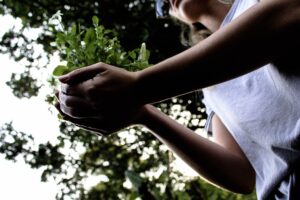
Tree Planting Guide for Lexington Landscapes
Planting the right tree in the right place can help meet your goals for your landscape. Keeping “right plant, right place” in mind will make it more likely that your new trees thrive for the long term.
Fall is a great time to plant because it offers cooler temperatures and more moisture in the soil-both ideal planting conditions.
1. Trees for Shade
Trees add beauty to landscapes, establish emotional bounds of property without a fence, cool the air, reduce noise, and provide natural flood- and climate control. They also serve as habitats for wildlife and enhance property values. A large shade tree with dense, rounded crown and leaves that turn yellow-orange in fall. It grows slowly and does well as a specimen tree in residential lawns.
Shagbark hickory grows to 60 feet tall with an interesting bark texture. In summer, it offers fragrant white flowers and a rich green canopy, while the golden yellow of autumn brings a welcome splash of color to yards. Its nuts are a tasty snack for squirrels and other wildlife. This species does best in wet, shady sites. A good choice for larger lawns and parks. And remember, if you ever need tree removal services in Lexington, KY, ensure you entrust this task to professionals for a safe and effective solution.
2. Trees for Privacy
Trees in the landscape contribute to a property’s visual appeal, enhance its distinct character, offer natural glare and heat protection, help stabilize soil and reduce noise pollution. They also assist in the conservation of energy, help control storm water runoff and provide habitats for wildlife.
Privacy trees aren’t a specific species of tree; instead, they are rows of trees planted tightly together to create a barrier that blocks an undesirable view. Evergreen trees like arborvitaes are ideal for this purpose since they retain their needles year-round and require no raking.
When planting privacy trees, make sure you space them according to their mature size. Otherwise, they may grow too close and end up obstructing your property or even causing structural damage to the house.
3. Trees for Food
A stunning sea of pristine bluegrass farmland surrounds Lexington. Take a tour of some of the 450 picturesque horse farms in the region, or drive the scenic back roads for a sunset drive through the lush sea of green.
Consider shade trees that also produce fruit. These include hophornbeam (Ostrya virginiana), redbud (Cercis canadensis), and serviceberry (Ribes serpyllum).
Homeowners are rethinking traditional lawns. The monoculture of non-native turf grasses that dominated suburban landscapes for decades offers little benefit to wildlife, and the water, fertilizers, and pesticides used on lawns have an enormous environmental cost.
4. Trees for Water
Trees are critical for retaining water, providing shade and cooling and reducing stormwater runoff. They also provide habitat for wildlife and reduce soil erosion. Homeowners are rethinking traditional lawns, considering alternatives such as natural ground covers or removing turf grass and replacing it with native shrubs and trees.
A low-growing shrub such as fothergilla (witch alder) (Fothergilla gardenii) is suitable for a small space, can withstand shade and drought and has attractive white flowers in spring. Mulch with bark, wood chips or pine straw 3 to 4 inches deep to conserve moisture and reduce weed growth. Avoid fertilizers with high nitrogen content until one year after planting.
Lexington’s stunning landscapes offer countless opportunities to connect with nature. Explore the trails at Shaker Village or Raven Run Nature Sanctuary, enjoy a horseback ride or take a scenic drive through our pristine bluegrass farm country.
5. Trees for Wildlife
Whether in natural or landscaped settings, trees are important to wildlife. Animals rely on trees for food and shelter, as well as places to reproduce. Trees also provide shade, glare and heat protection as well as soil stabilization, wind erosion control and help to regulate the climate.
Plant a native milkweed (Asclepias tuberosa) to attract butterflies and bees to your yard. This plant provides a vital food source for monarch butterflies.
Conduct a soil test to check the nutrient and percolation levels of your planting area. This will play a large role in the health of your tree throughout its entire life. If the soil is poor, amend it with organic material to improve its quality.f